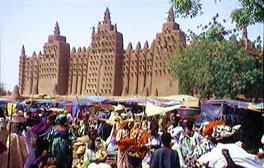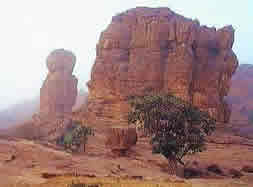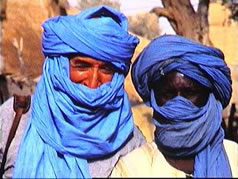
After passing 11 countries between Lagos and Dakar I thing that it is Mali who have best places of interest in this part of Africa. There are diversity of landscapes, rich folklore and historical landmarks to see. Apart from truck expeditions you have a choice of two methods to explore Mali. First is to establish small group of Travellers and to rent 4WD car with local driver. In such case travel agency provides camping equipment, basic food and fuel and the cost will be around 100 USD per day per person. Second method is to travel around using very crowded local transportation. That is how I explored Mali. It cost me some 25 USD a day and gave me opportunity to taste quite different Africa.
From Bamako to Djenne
Capital city has not much to offer. It is worth to see National Museum and then take the taxi ride uphill to the view point for nice panorama of the city and the river (if it is not harmattan day). I stayed at basic but inexpensive Maison de Jeunes (youth hostel). They charge 3000 for single room with fan.
Bamako acts as a gateway to the whole country. But remember that there is also direct “side door” to the most interesting Mali areas: gravel road from Ouahigouya (Burkina Faso) to Koro on the doorstep of Dogon Country. Daily truck is passing border on this route and it cost 2000 CFA.

But most people start from Bamako going east. On the route to Timbuktu and Dogons it is definitely worth to make a little detour to Djenne one of the most impressing towns in West Africa. During the 15th and 16th century it was a important trading center. The highlight of the town is Grand Mosque prettiest and largest example of mud-brick Sahelian architecture. Entrance is restricted to the Moslems but for a small fee (500 CFA) you can enter the roof of the opposite house to take excellent picture.
It is worth to be in Djenne on Monday morning. It will give you a chance to see colorful market in front of the mosque. Djenne has also labyrinth of narrow streets to explore. If you will accept one of the ever-present guideboys (for 1000) he will show you outstanding buildings, coranic schools, workshops etc. In Djenne I stayed at Le Campement hotel (13.000 for double with bath and fan) but there is also option for tight budget Travellers: “Che Baba” who charge just 2500 for the mattress on the floor.
Mopti & Dogon Country

Mopti is large commercial town and main transportation hub for eastern part of Mali. There is not much to see regarding monuments (mosque and surrounding old streets are only tourist objects) but the “must to see” is port on the Bani river very picturesque with dozens of long pinasses and piles of calabash, mat and other goods. What is irritating in Mopti that there are hordes of touts they will follow you everywhere. They will offer of course to be your guides to nearby Dogon Country…

Arriving from Burkina we found our Dogon guide in Koro. Or in fact he was waiting for the truck coming from Ouagihuiya. His name is Oumar Guindo and I can recommend him to other globies. After hard bargaining we fixed the price: 11.500 CFA per person per day in the group of 3. It is important to make sure what is included in the price: guidance, meals, entry to the villages, overnight stays, porters and final car transfer to Bandiagara.
Escarpment where Dogon live is 150 km long. Villages to visit are both on the upper and lower level. Between levels there is limited number of country roads (at Dourou at Kani-Kombole) and paths. There are no signs on the paths so sometimes it is not easy to find the way guide is very useful. Walking on your own is possible but require good map and much more time). Those who travel through Mali by rented car usually come to Sanga on the upper level and make one or two day excursion to the villages on the lover level.
Due to limited time and money we spend in Dogon Country three days only.
Day one: After first night in Dourou on the top we made round trip excursion down to Nombori (some 5 km each way). Walking shoes are required. Landscapes are excellent. In Nombori apart from traditional stone granaries and houses we accidentally had opportunity to see mask dances performed for other group (performance took about an hour and they charged from us 5000 CFA for taking pictures well worth the price). After return to Dourou we saw there in the afternoon colorful local market (markets are in the afternoons and on irregular schedule so it is not possible to plan such visit ahead). Late in the day we took 7-km walk south to the village of Begnimato where we stay overnight. In the villages you have a choice of sleeping in the stone or mud-brick house (mat or hard bunk only provided) or on the roof. Mornings are cool so sleeping bag is useful. Do not expect any electricity to charge your batteries.
Day two : After very basic breakfast (millet cakes) we visited local school (donations are welcome) and walk 10 minutes to the viewpoint on the escarpment. Panorama from the cliff is impressive if not disturbed by harmattan dust. Back in Begnimato we walked 10 km down to Ende large village at the foot of the escarpment. There are even basic guesthouses and nice artifacts on sale. Each part of the village has his own togina shaded men meeting place with beautifully carved pillars. In the heat it require some effort to reach abandoned ancient houses at the foot of the cliff. Sand is everywhere…
Day three : After one-hour walk along dozens of baobab trees we reached Teli with nice mosque, quite large “maison de passage” and ancient dwellings hidden under the cliff even better preserved that those in Ende, with intriguing paintings. Continuing our trek at the foots of the escarpment we reached village Kani-Kombole. Then climbing uphill 5 km we finished our trip in Djiguibombo (7 hours from Ende). Djigibombo has interesting stone houses especially that where local quack treats his patients. Prearranged car took us to Bandiagara and another bache (pickup) – to Mopti.
Be very careful accepting local food. Be sure that your chicken-rice is fresh and well boiled or fried! Stomach problem are common as it is hot and sanitary conditions are poor. Sealed mineral water is available in every village but you will probably get only half bucket of water to do your morning and evening toilette.
Overland to Timbuktu

Town of Mopti is natural gateway for the people who head to legendary Timbuktu. To get there (If you do not have a car) you have a choice of plain (2 or 3 times a week 50.000 CFA one way), boat (rather irregular schedule: 8000, 2-3 days) or 4WD vehicle. For single me was not so easy to find seat in the car. There is travel agency who charge 260.000 CFA for 3-days round trip landcruiser expedition to Timbuktu. I was lucky to be in Mopti on the market day so it was possible to find truck carrying local people. They charged from me 30.000, but at the end of the trip my local companions said that they have been charged 15.000 only. Yes, that is Mali Do not believe touts until the car will move. Ask for ticket if they want payment in advance!
It took us 20 hours by our old landrover (mainly by night, loosing the way several times) to reach the bank of Niger. Usually there is ferry crossing in the wastes. But sometimes (as it was in our case) the ferry is broken and you are forced to use small pirogue to cross the river (1000 CFA). Then, from the pier on the other side another vehicle for 3000 will take you to Timbuktu which is still 21 km away. On the outskirts of the oasis there is control post where all foreigners must pay 5000 entry fee. As a reward you have free access to the city museum.

Timbuktu was off limits for Europeans until 19th century. Timbuktu is very hot place with there old mosques in Sahelian style, mud brick houses, nomad tents and small market. There are also marked houses where first European explorers stayed. But the main attraction could be camel ride to the Tuareg camp in the desert. After bargain you can do it for 8000 CFA per person (half day, with unlimited pictures). You ride the camel, they will show you their tents, offer a tea and souvenirs (for extra CFA). Yes, it was a highlight of my stay in Mali!
PRACTICALS
Cool period lasts from November to March but is period when dusty wind harmattan blows from the desert reducing visibility. Rest of the year is very hot. Light rains occur from June to September. I suggest May and October as a best time to visit Mali.Visas are required and not possible to arrange at the border. While in Mopti, Gao and Timbuktu tourist must go to the police post and register his passport. They charge 1000 CFA for this procedure. It is better to follow the rule due to frequent road controls.
Tourist information Planing your voyage you can use Lonely Planet (“West Africa on a shoestring”) guide. In Bamako there is tourist information office but do not expect too much. Basic knowledge of French is recommended. Internet resources are limited. See more my pictures and maps athttp://kontynenty.tpi.pl/s3entravel.htm
Money: Franc of West Africa (CFA). 1 USD is worth approx.700 CFA
Sample prices:
Twin room with fan in the inexpensive guesthouse 13000 CFA. Minibus or pickup rides: Bamako-Djenne 5000, Djenne-Mopti – 2000, Bandiagara Mopti 1200+500 for backpack. French baguette 150, coke 200 CFA, big bottle of beer 1000, mineral water 600, postcard 250, entry ticket to the museum 500.
